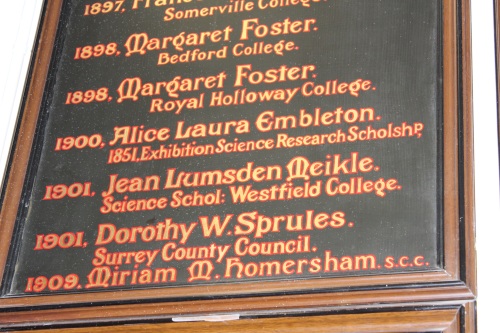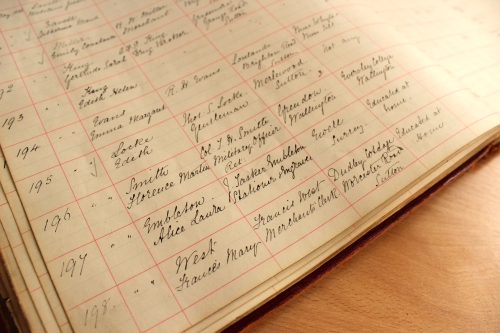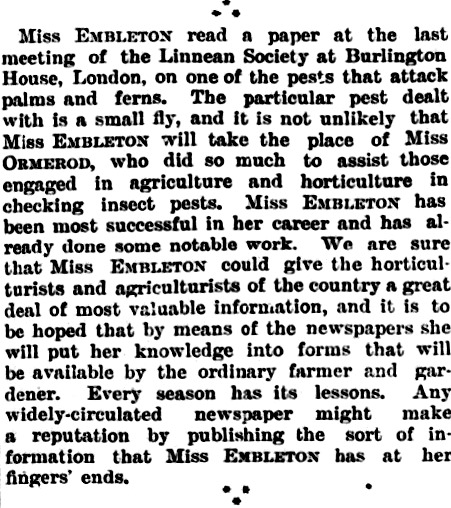This guest post comes from Sue James, a History teacher at Sutton High School, Greater London, who has been researching the life and career of one of their former students, Alice Embleton. As well as attending Sutton High, Alice was one of the first women to study sciences at the University College of South Wales and Monmouthshire. As part of our celebrations for International Women’s Day 2018, we’d like to share her story.
ALICE LAURA EMBLETON c. 1876-1960
I came across Alice Embleton’s name quite by accident. It was on one of the honours boards here at Sutton High School, but this particular one had been covered over by a stage curtain. With the curtain pinned back on an inset day, Alice’s name was clear to see, and next to it was written: 1900 winner of the 1851 Exhibition Science Research Scholarship. Spurred on by the support of our Biology Department, and knowing that Alice may make an inspirational story for current students in an upcoming school science assembly, I started my research.
Our school magazines, which date from 1895, have been digitised so it was quite easy to make a start, and her name appeared a number of times in the early editions. Alice was cited as being at Aberystwyth University, but the archivist there told me that this was a mistake, and that she was at Cardiff instead. I was not too surprised at the error, as the school register records that Alice had left Sutton High early, at the age of 15, due to ‘pecuniary reasons’. It is a measure of the academic prowess that Alice showed that the school followed her progress, even if they did not always get the details right.
The archivist at Cardiff University was also enthusiastic about Alice. She quickly found out that Alice was one of the first cohort of women studying for a science degree; there were 5 women and 16 men on her course between the years 1895 and 1899. Alice won scholarships which paid for the course, and graduated with a Baccalaureus in Scientia, first class.
This degree was just the start of Alice’s academic success. The archivist at Aberystwyth had affirmed that Alice was an interesting subject and she also pointed me in the direction of Welsh Newspapers Online. There were several references to Alice, and it became apparent that she had won a number of awards and scholarships in the scientific world. There were also references to her achievements being considered ‘firsts for a woman’, which made it very exciting. I knew I was on to a scientist of note, perhaps even a trailblazer.
Awarded in 1900, The Great Exhibition Science Research Scholarship granted Alice £150 a year for two years, unusually extended to three. She used the money to work at the Balfour laboratory at Newnham College, Cambridge, followed by a further period of study at the Sorbonne. She was the first foreigner and the first woman to study under Professor Marchal. In 1904, Alice won the Mackinnon studentship of the Royal Society for research into Biological Sciences, which was described as a ‘unique distinction for a woman’. There is also a reference to Alice being sub-editor of the Zoological Record, and working at the South Kensington Museum, before furthering her research in Scandinavia.
Alice’s focus, and the reason for all the awards, was her research into pesticides to help increase crop production. Welsh Newspapers Online pointed to Alice having a link to the prestigious Linnean Society in Burlington House in London.
She was among the first women to be admitted to the society and, in 1911, became its first female speaker. Her paper was entitled: ‘Anatomy and Development of a Hymeropterous Parasite of a Scaly Insect (Lecanium Hemisphoericum)’. The archivist at the Linnean Society was very helpful and sent me copies of Alice’s correspondence with the Society, a link that lasted from 1905 until 1917, when she resigned.
At this point I had enough information for an assembly in honour of Alice, but there then appeared a twist in the story. The 1911 census showed that Alice was a visitor at the home of Alderman Charles Wray and his daughter Cecilia, in Fairfield House, Barnsley. Alice gave her occupation as working in cancer research, while Cecilia had described herself as ‘getting votes for women’. This had been crossed out, presumably by the enumerator, and replaced with ‘no occupation, private means’. The evidence seemed to indicate that Cecilia was a suffragist and provided the possibility that Alice was too. The L.S.E. Women’s Library has a photograph of a group of women entitled ‘Campaigners for Women’s Suffrage in Barnsley, January 20th1910’. An ‘A.J. Embleton’ is in the line-up with C. Wray. Although J is recorded as a middle initial, rather than the L that appears in school records, it is reasonable to deduce that this is our Alice, especially as her connection with Cecilia was strong. The two appeared again in the 1939 census, and the Barnsley Chronicle of July 31st 1909 recorded a meeting of the Barnsley Women’s Suffrage Society, in which secretary Cecilia Wray presided over the passing of a resolution moved by ‘Miss Embleton’. Additionally, the L.S.E. has some correspondence between Celia Wray and Alick Embleton and Vera (Jack) Holme, the chauffeur of Emmeline Pankhurst, which strengthens the case for Alice being a suffragist.

Miss AJ Embleton, Miss O Royston, Miss C Wray, Miss M Fielden and Miss E Ford, photographed outside the offices of the Barnsley Chronicle, 20 January 1910.
How amazing that a hidden name on an honours board could lead to a tale of scientific excellence and a timely connection with women’s suffrage. Alice could have been a forgotten student, but instead she has become an inspiration and a personification of at least part of our school’s motto: ‘Fortiter, Fideliter, Feliciter’ (bravely, faithfully, happily). She did feature in the science assembly, and there is now a proposal to rename the school biology prize, ‘The Alice Embleton Biology Prize’.





